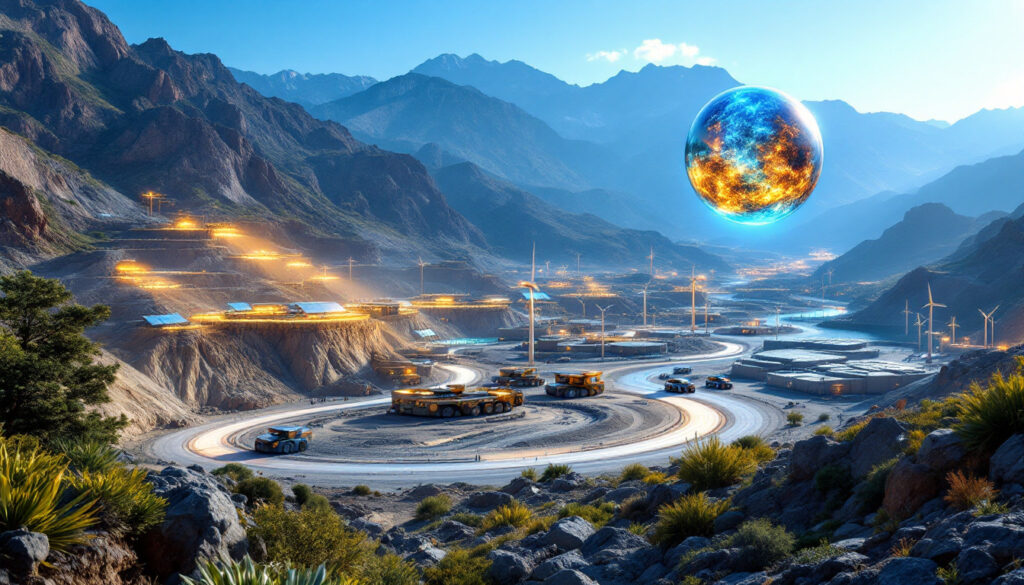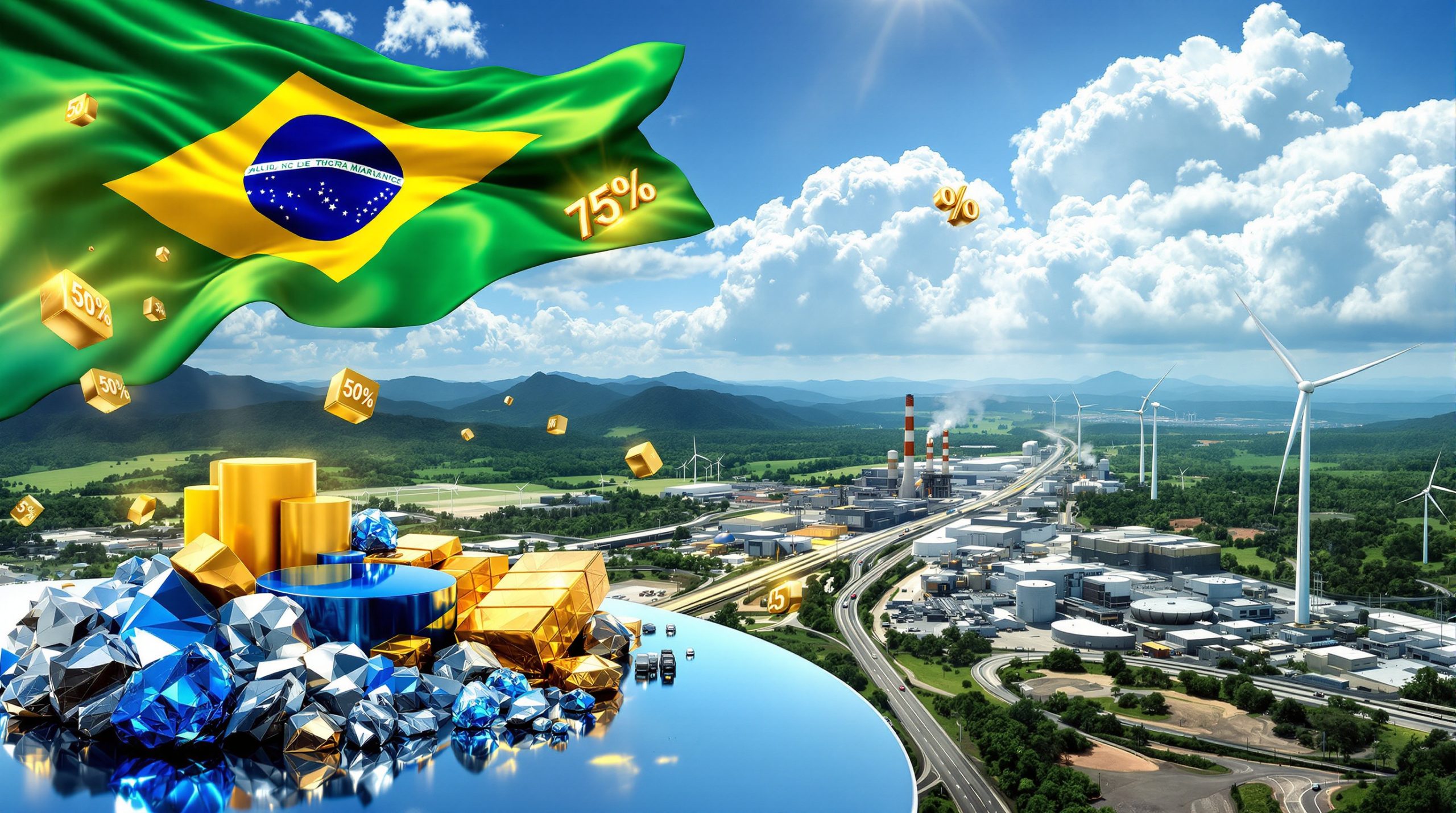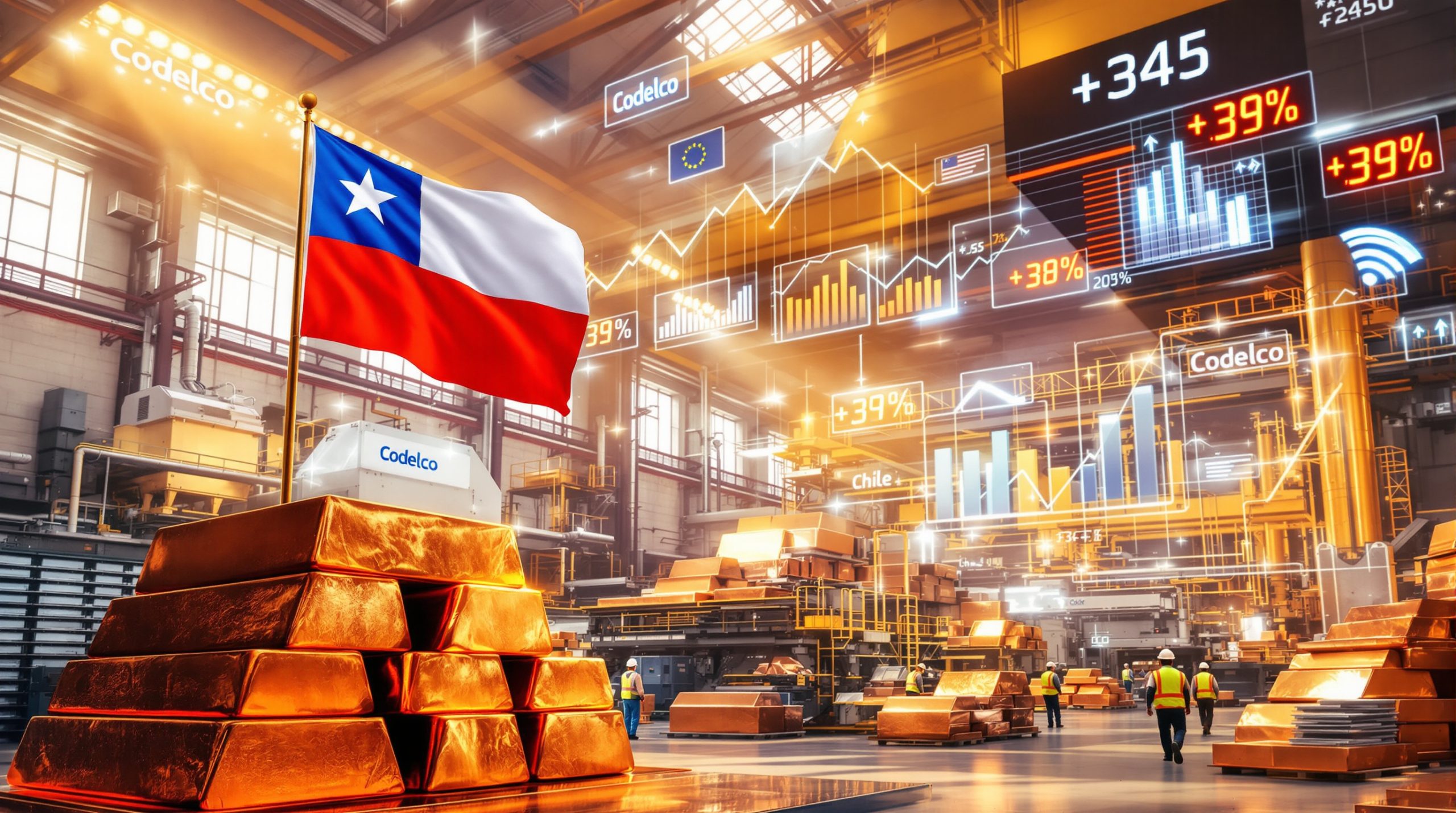How Is the Mining Industry Working Toward Decarbonization?
The mining sector stands at a critical crossroads, responsible for 4-7% of global greenhouse gas emissions while simultaneously providing the essential materials needed for clean energy technologies. This paradox presents both challenges and opportunities as the industry works to reduce its carbon footprint while meeting surging demand for transition minerals.
Mining companies worldwide are increasingly recognizing that decarbonising mining isn't just an environmental imperative but also a business necessity. With methane from coal mines constituting 75-85% of sectoral emissions, the industry faces pressure from investors, regulators, and consumers to transform operations while scaling up production of critical minerals that enable the broader energy transition.
The industry's approach to decarbonization varies significantly, from incremental improvements to radical transformations. Forward-thinking companies are implementing green transformation strategies that include renewable energy solutions, electrifying vehicle fleets, optimizing processes, and in some cases completely reimagining their operational models to eliminate rather than merely offset emissions.
What Makes Mining Decarbonization So Challenging?
The Carbon Intensity of Traditional Mining Operations
Mining operations traditionally rely heavily on fossil fuels, with diesel-powered equipment dominating extraction, processing, and transportation activities. The sector's 28,000 specialized mining trucks alone emit approximately 69 million tonnes of CO₂ equivalent annually, highlighting the scale of the challenge.
Remote mine locations often necessitate off-grid power solutions, historically dependent on diesel generators or other carbon-intensive energy sources. Approximately 70% of mining operations worldwide lack reliable grid connectivity, making the transition to cleaner energy particularly complex.
The energy demands of mining operations are substantial and consistent, requiring 24/7 power availability regardless of weather conditions or time of day. This operational reality has historically made fossil fuels the default choice due to their reliability and energy density.
The Rising Demand for Critical Minerals
The transition to clean energy is dramatically increasing demand for specific minerals:
- Lithium demand projected to increase 8x by 2040
- Nickel and cobalt demand expected to double by 2040
- Copper demand anticipated to rise by 50% by 2040
This creates a fundamental tension: producing more minerals while reducing emissions. Meeting these projections will require mining more minerals in the next 30 years than throughout all of human history, according to industry experts.
The energy-intensive nature of mineral processing compounds the challenge. Lower-grade ores require more energy to process per unit of final product, and as high-grade deposits become depleted, the energy intensity of mining operations naturally increases without technological intervention.
Unique Site-Specific Challenges
Each mining operation faces distinct decarbonization hurdles based on:
- Geographic location and climate conditions
- Proximity to existing power infrastructure
- Mineral type and extraction requirements
- Local regulatory frameworks
For example, lithium extraction in the arid conditions of Chile's Atacama Desert faces water scarcity issues that impact energy choices, while underground coal mines in China must address methane capture and utilization to reduce their climate impact.
Which Companies Are Leading the Mining Decarbonization Effort?
Fortescue's Ambitious "Real Zero" Strategy
Australian iron ore giant Fortescue has positioned itself at the forefront of the mining decarbonisation revolution with its rejection of traditional "net-zero" approaches in favor of "real zero" emissions:
- Committed to eliminating Scope 1 and 2 emissions across its 87,000 square km Pilbara operations by 2030
- Investing $6.2 billion in decarbonization initiatives
- Developing proprietary technologies rather than relying on carbon offsets
- Deploying 2-3 gigawatts of solar and wind power with battery storage
Fortescue's Chairman Andrew Forrest has been particularly vocal about the approach, stating that "'Net-zero' is a dangerous fallacy; only absolute emission cuts matter." This philosophy has driven the company to pursue elimination rather than offsetting of carbon emissions.
Unlike many competitors who rely on carbon credits or gradual transitions, Fortescue is implementing a complete system overhaul, demonstrating that mining companies can be climate solution providers rather than just reducing their impact.
Key Technological Innovations at Fortescue
Fortescue's approach includes several groundbreaking technologies:
- Regenerative train systems that harvest gravitational energy during 400-meter elevation drops across their 760 km rail network
- Ammonia-powered locomotives using dual-fuel systems that reduce diesel consumption by 90% in pilot tests
- Green electric vehicle prototypes developed in nine months through accelerated R&D cycles
- Extensive renewable energy transmission networks connecting solar and wind assets
The company's rapid prototyping approach has compressed what would typically be multi-year development cycles into months, allowing for faster iteration and implementation of zero-emission solutions.
This technological transformation is supported by a corporate culture that prioritizes innovation and accepts calculated risks to achieve meaningful decarbonization outcomes rather than incremental improvements.
What Technologies Are Transforming Mining Equipment?
The Evolution of Zero-Emission Mining Vehicles
With approximately 28,000 specialized mining trucks operating globally and emitting around 69 million tonnes of CO2 equivalent annually, vehicle electrification represents a significant opportunity:
- Industry collaboration through the International Council on Mining and Metals (ICMM)
- Partnerships with equipment manufacturers like Caterpillar, Komatsu, and Sandvik
- Battery electric technology gaining momentum with multiple prototypes in testing
- Zero-emission vehicles expected at scale by 2030, a decade ahead of earlier projections
According to Bryony Clear Hill of ICMM, "Multi-stakeholder collaborations accelerate technology diffusion across OEMs," enabling faster adoption of innovative solutions across the industry.
Key technical challenges include developing battery systems with sufficient energy density for heavy equipment, creating charging infrastructure for remote operations, and ensuring durability in extreme conditions. Despite these challenges, manufacturers have made remarkable progress, with prototypes achieving 2.5 kWh/km efficiency for 400-ton haul trucks.
Renewable Energy Integration at Mine Sites
Remote mine locations are increasingly finding economic advantages in renewable energy:
- Kamoa Copper mine in DRC partnering with CrossBoundary Energy for baseload solar power
- 222 MW solar array with battery storage providing 30 MW of reliable power
- Renewable solutions now cheaper than diesel alternatives ($0.08/kWh vs. $0.15/kWh for diesel)
- No upfront costs through power purchase agreement models
Matthew Tilleard of CrossBoundary Energy notes that "Baseload solar solutions are now cheaper than diesel, irrespective of climate beliefs," highlighting that economic incentives are now aligned with environmental goals.
This shift is enabled by the dramatic decline in renewable energy costs, with solar and wind infrastructure prices falling 89% and 70% respectively since 2010. The integration of battery storage systems allows mines to maintain reliable power even during periods of low renewable generation.
What Are the Regional Variations in Mining Decarbonization?
Geographic and Regulatory Disparities
Decarbonization progress varies significantly across regions due to:
- Availability of government support and enabling policies
- Grid connectivity and local electricity carbon intensity
- Access to power purchase agreements with independent producers
- Corporate commitment levels varying by company size and origin
Australia leads in many respects, with its mining sector benefiting from up to 82% renewable penetration in some regions, enabling electrified ore processing. By contrast, operations in countries with less developed infrastructure face greater hurdles in transitioning away from fossil fuels.
The regulatory environment creates additional complexity, with some jurisdictions implementing carbon pricing mechanisms while others provide few incentives for emission reductions. This disparity can lead to "carbon leakage," where high-emission operations migrate to regions with fewer environmental restrictions.
The Chinese Mining Company Factor
Chinese mining companies, which are increasingly dominant in strategic mineral supply chains, present a unique challenge:
- Projected to control 46% of global cobalt supply by 2030
- Generally at earlier stages of decarbonization efforts
- Facing fewer regulatory pressures to reduce emissions
- Some showing interest but lacking immediate incentives for action
According to Grégoire Bellois of the Intergovernmental Forum on Mining, "Chinese miners lack incentives; carbon tariffs may redirect trade flows to Asia," suggesting that without global policy alignment, decarbonization efforts could lead to market fragmentation rather than universal improvements.
This disparity raises concerns about "green" versus "brown" supply chains for critical minerals, with certain markets potentially accepting higher-carbon materials while others impose strict standards. The result could be a bifurcated market with price premiums for low-carbon minerals.
How Will Policy Shape Mining Decarbonization?
The Potential Impact of Carbon Border Adjustments
The European Union's proposed Carbon Border Adjustment Mechanism (CBAM) could significantly influence global mining practices:
- Would impose levies (potentially $50/tonne CO₂) on carbon-intensive exports to EU markets
- Could create market access barriers for high-emission producers
- May result in market segmentation with carbon-intensive exports redirected to less regulated markets
- Potential to drive broader industry transformation if widely adopted
Industry analyses suggest that high-emission nickel producers could lose up to 20% of their EU market share once such mechanisms are fully implemented, creating strong financial incentives for decarbonization.
The effectiveness of these policies depends on their global adoption; if limited to certain markets, they may simply redistribute rather than reduce emissions. However, if major economies align their approaches, the impact on mining practices could be transformative.
The Need for Enabling Policy Frameworks
Successful mining decarbonization requires supportive government policies:
- Frameworks enabling power purchase agreements
- Support for independent power producers
- Grid decarbonization initiatives
- Research and development funding for innovative technologies
Hayley Zipp of ICMM emphasizes that "Enabling PPAs and independent power producers is pivotal for remote sites," highlighting the critical role of regulatory frameworks in facilitating private-sector decarbonization efforts.
Some governments are taking proactive steps, such as Canada's $1.5 billion Critical Minerals Infrastructure Fund, which supports both extraction and decarbonization simultaneously. Similar programs addressing the unique challenges of the mining sector could accelerate the transition.
What Are the Economic Considerations of Mining Decarbonization?
The Changing Cost Dynamics of Renewable Energy
Economic factors increasingly favor decarbonization:
- Steep decline in solar panel and battery storage costs
- Renewable infrastructure now cheaper than gas equivalents in many contexts
- Off-grid renewable solutions becoming more cost-effective than diesel generators
- Potential competitive advantages for early adopters
Dino Otranto, Fortescue CEO, confirms that "Renewable infrastructure is now cheaper than gas equivalents, making decarbonization economically viable without subsidies," revealing that the business case for clean energy in mining has fundamentally shifted.
This cost evolution enables innovative financing models like the zero-upfront-cost approach used at the Kamoa Copper mine, where a 25-year power purchase agreement provides electricity at $0.08/kWh compared to diesel's $0.15/kWh, generating immediate operational savings.
Investment Requirements and Returns
The transition requires significant capital investment:
- Fortescue's $6.2 billion decarbonization program demonstrates scale of investment needed
- Alternative financing models emerging, such as no-upfront-cost power purchase agreements
- Potential long-term operational cost savings
- Market access considerations as carbon regulations tighten
While the initial capital outlays can be substantial, the long-term economics increasingly favor low-carbon operations. Companies that delay decarbonization may face higher financing costs, limited market access, and competitive disadvantages as global policies evolve.
The investment case is further strengthened by the risk of stranded assets; infrastructure designed around fossil fuels may become obsolete before the end of its intended lifespan as clean energy alternatives continue to improve in performance and decrease in cost.
Is Complete Mining Decarbonization Achievable?
Realistic Pathways and Limitations
Industry experts hold varying views on the feasibility of complete decarbonization:
- Some skepticism about industry-wide "real zero" by 2050
- Significant acceleration in mineral production creating additional challenges
- Expectation that more minerals will be mined in the next 30 years than throughout human history
- Recognition that every emission reduction represents progress
The sheer scale of predicted mineral demand creates a fundamental tension; producing vastly more material while simultaneously eliminating emissions requires unprecedented technological and operational transformation.
Certain processes, particularly in high-temperature metallurgical applications, present persistent technological challenges for full decarbonization. Solutions like green hydrogen show promise but remain in early stages of commercial deployment for these specialized applications.
The Critical Role of Innovation
Technological innovation remains central to decarbonization efforts:
- Need for continued research and development in battery technology
- Exploration of alternative fuels for heavy equipment
- Development of more efficient extraction and processing methods
- Implementation of AI in mineral mining and digital twins in mining to optimize energy use
Advanced technologies like ventilation-air methane oxidation systems for coal mines and high-temperature electric furnaces for metal processing represent critical innovations for addressing particularly challenging emission sources.
The industry must also look beyond its immediate operations to consider the full lifecycle of minerals, including more energy-efficient beneficiation processes and innovations in recycling to reduce the need for virgin material extraction.
What Can the Mining Industry Learn from Early Adopters?
Knowledge Sharing and Best Practices
Fortescue's approach demonstrates the value of transparency and collaboration:
- Opening doors to competition and suppliers
- Demonstrating technical feasibility
- Sharing lessons learned through implementation
- Setting ambitious targets that challenge industry norms
By publishing detailed plans and results, early adopters create valuable knowledge resources that help other companies avoid costly missteps and accelerate their own transitions. This "lighthouse effect" can have a multiplier impact across the industry.
Multi-company initiatives like the ICMM's Innovation for Cleaner, Safer Vehicles program create platforms for shared learning, helping to overcome the proprietary nature of many mining technologies and enabling faster industry-wide progress.
The Importance of Corporate Leadership
Executive commitment to decarbonization drives progress:
- Fortescue Chairman Andrew Forrest's vocal criticism of "net-zero" approaches
- Setting ambitious, science-based targets
- Willingness to invest in proprietary technology development
- Creating corporate cultures that prioritize innovation
Leadership that frames decarbonization as strategic rather than merely compliance-driven tends to achieve more substantial results. Companies with board-level champions and executive compensation tied to emission reductions demonstrate faster progress than those treating climate as a peripheral issue.
The most successful companies integrate ESG and sustainability insights throughout their operations rather than treating it as a separate sustainability initiative, ensuring that all business decisions consider climate impacts as a core decision factor.
How Does Mining Decarbonization Support the Broader Energy Transition?
The Mineral Supply Chain Imperative
Mining decarbonization is essential for truly sustainable clean energy technologies:
- Reducing embedded carbon in critical minerals
- Ensuring the full lifecycle benefits of clean energy technologies
- Meeting growing consumer and regulatory demands for responsible sourcing
- Supporting broader industrial decarbonization efforts
The embodied carbon in minerals like lithium, cobalt, and rare earth elements significantly impacts the lifecycle emissions of technologies like electric vehicles and wind turbines. Decarbonising mining is therefore essential to maximize the climate benefits of the energy transition.
As regulations like the EU's battery directive and the U.S. Inflation Reduction Act increasingly tie market access to sustainability metrics, low-carbon minerals may command premium prices and preferential market access, creating additional economic incentives for decarbonization.
Creating a Circular Materials Economy
Beyond initial decarbonization, the industry must consider:
- Material recycling and recovery
- Minimizing waste throughout the value chain
- Extending equipment lifecycles
- Developing closed-loop systems where possible
The EU's 2030 battery recycling efficiency target of 70% exemplifies how circularity policies can reduce primary extraction needs while decreasing overall environmental impact. Companies that incorporate circularity principles into their business models may find competitive advantages in a resource-constrained future.
Urban mining—recovering minerals from discarded electronics and industrial waste—represents a growing opportunity to supplement primary extraction with lower-carbon alternatives. The carbon intensity of recycled minerals is typically 60-90% lower than virgin materials, depending on the element.
FAQs About Mining Decarbonization
What percentage of global emissions come from mining?
Mining accounts for approximately 4-7% of global greenhouse gas emissions, with 75-85% of the sector's emissions coming from methane released from coal mines.
Which mining company has the most ambitious decarbonization target?
Fortescue has set one of the industry's most ambitious targets, aiming for "real zero" emissions (eliminating rather than offsetting) across its operations by 2030, rather than the more common 2050 timeframe.
How much will demand for critical minerals increase for clean energy technologies?
According to the International Energy Agency, reaching net-zero will require a 50
Ready to Capitalise on the Next Major Mineral Discovery?
While the mining industry tackles decarbonisation challenges, Discovery Alert's proprietary Discovery IQ model identifies significant ASX mineral discoveries in real-time, helping investors seize actionable opportunities ahead of the market. Start your 30-day free trial today at Discovery Alert to gain your market-leading advantage.




